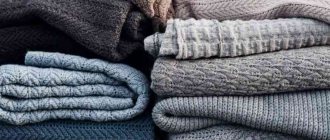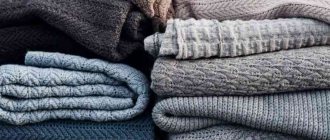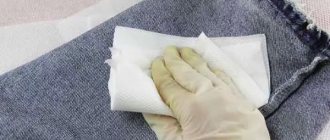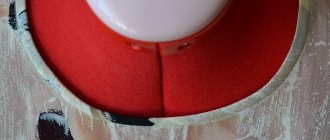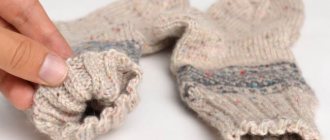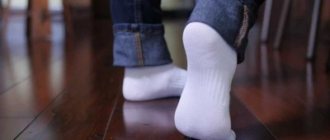Bleaching with household chemicals
The line of brands Vanish, Persol, Amway and Help contains products for bleaching wool products. Chemical bleaches are used according to the instructions on the package. Exceeding the treatment time with household chemicals leads to damage to wool fibers.
To wash woolen items with colored inserts, oxygen bleaches are used.
Shampoo for bleaching dog hair shows good results.
White
To prepare a solution, stir 50 ml of the product in 7-10 liters of warm water (30-40°C). The wool product is completely immersed in the solution and kept for 30-40 minutes, periodically turning over for uniform bleaching.
Chlorine is an aggressive component. The use of chlorine-containing bleaches is recommended in cases where other bleaching methods have not brought the desired result.
Specialized bleaches
Specialized bleaches for wool and silk (Perox, Vanish, etc.) are sold in hardware stores; their dosage and exposure time are indicated on the packaging. The effect of such products is based on the release of oxygen molecules, which remove contaminants from animal fibers without damage.
Machine washable
When bleaching woolen items during washing in an automatic machine, it is important to follow the following recommendations:
- use detergents for wool products;
- the amount of special bleach should not exceed the amount recommended in the instructions;
- washing temperature no more than 40°C;
- set the spin to the lowest speed;
- do not use machine drying.
Help: If you soak woolen items for 15 minutes in a soda solution (50 grams of soda per 5 liters of water) before washing, then you will not have to wash them additionally.
How to bleach a yellowed white blouse, get rid of marks under the arms
Yellowness does not appear throughout the entire product; color changes occur in certain places, so it is enough to limit the treatment to problem areas.
The most common areas of yellowing are the armpits, sleeve cuffs, and collars of blouses and shirts.
Several remedies will help to qualitatively eliminate yellowness:
- Lemon will solve the problem in minutes. Rub the problem area generously with a fresh cut and rinse.
- Soda solution is used to clean synthetic fabrics. It is applied directly to problem areas using a cotton swab.
- Alcohol will easily remove unattractive marks on silk. Wipe the product with a cotton pad until the stain disappears completely.
How to restore whiteness to a white bra without boiling, reviews and videos
The result must be secured by washing as usual.
Traditional methods
You can bleach white woolen items in more gentle ways that are effective and do not destroy the wool fibers. The ingredients needed for bleach solutions are inexpensive and found in every home.
Hydrogen peroxide
Mix peroxide in warm water in a ratio of 8:1. Calculate the volume of the solution so that the product is completely immersed in it. Leave the woolen jacket soaked in the mixture for 6-8 hours, then rinse thoroughly.
Soda (sodium bicarbonate)
Has good whitening characteristics. You can use both food grade and calcined. Baking soda added during machine washing will soften the water and improve the quality of the wash.
Dilute 100 grams of soda in 5 liters of cold water (up to 30°C) and place the woolen item for several hours. Soaking time depends on the degree of contamination. To increase the whitening effect, add 1 teaspoon of ammonia to the solution. When the bleaching result has reached the desired level, the item is removed and rinsed.
Important: The temperatures during bleaching and rinsing must be the same, otherwise the wool will fluff up.
Lemon acid
To get rid of yellowness on knitted items, soaking in a solution of citric or boric acid is suitable. The composition is prepared in the proportion of 1 tbsp. spoon of acid per 1 liter of water. The product is completely immersed and left until the desired result is obtained (usually 6-8 hours), after which it is thoroughly rinsed.
Help: When bleaching wool in any container, items must be turned over periodically to ensure uniform processing.
Chalk
For bleaching, prepare a solution at the rate of 1 kg of chalk per 400-500 grams of wool. The required amount is diluted in warm water in the proportion of 1 kg of chalk per 3 liters of water. Soak for 40-60 minutes, periodically stirring the composition to ensure even penetration into the fibers.
Rinse thoroughly, the last time with conditioner to make the product soft.
Ammonia
Whitens well and removes old stains.
- Soak clothes in the required amount of solution at the rate of 100 grams of ammonia per 10 liters of warm water for 30 minutes. Then, lightly wringing, wash in the machine with an additional rinse. If the smell of alcohol does not go away, rinse again with the addition of conditioner. Dry in the fresh air.
- In 2.5 liters of filtered water at a temperature of 40°C, dilute 50 ml of ammonia and 30 grams of salt. The container containing the woolen item is covered with cellophane and kept for 45 minutes. Then lightly hand wash and place in the washing machine to rinse with added conditioner.
- Dissolve 10 ml of ammonia in 6 liters of water and thoroughly rinse the sweater in the resulting composition. Squeeze lightly. Then for 30 minutes they are placed in a solution of 5 ml of hydrogen peroxide and 1 ml of ammonia per 1 liter of water. Rinse in a machine with air conditioning.
Salt
This whitening method is one of the most gentle. In addition, wool fibers treated with salt become softer.
Soak a woolen jacket in a saline solution (50 grams of salt per 10 liters of water) for 5-6 hours, after which it is rinsed well. If the whiteness of the product is not satisfactory, the procedure is repeated.
Laundry soap
Boiling has always been considered very effective in combating yellowness and grayness of light-colored fabrics. This bleaching method can also be applied to woolen products:
- Grind the laundry soap on a grater to make fine shavings.
- Pour it into a metal container with cold water and stir.
- Put the solution on the fire, and when it becomes warm, put a jacket or hat in the basin. Bring the mixture with clothes to a boil and remove from heat after 10 minutes.
- Drain the boiling water and add warm water. Rinse things thoroughly and drain the mixture.
- Refill with warm water at a temperature of 30-40 degrees and add 5-6 tbsp to it. vinegar for 3-4 liters. Stir.
- Dip white yarn into the mixture, rinse and leave for 5 minutes.
- Drain the water and wring out the product.
After such bleaching, woolen items do not need to be washed with special cleaning agents.
Advice. Do not store white woolen pullovers and hats together with colored items.
Wool threads
Gray or yellowed wool threads are bleached at high temperatures.
To do this you need:
- Laundry soap shavings are diluted in hot water;
- Boil the yarn in the solution until the desired result is achieved;
- rinse in warm water;
- During the last rinse, add vinegar to the water (1 tablespoon of vinegar per 2 liters of water).
The threads are also bleached with baby soap. To do this, place a skein of thread in a soap solution and boil for 20-30 minutes, turning it over periodically. If the solution turns dark, prepare a new one and repeat the procedure.
Yarn
To prevent the wool from matting, the yarn is processed at a temperature of 50°C. Bleaching is carried out in the following order:
- Skeins of yarn are tied with natural threads.
- Dilute a neutral detergent in the proportion of 1 gram per 1 liter of water. facilities.
- Thoroughly rinse the yarn in the solution and wring it out.
- Hydrogen peroxide (1/3 of the weight of the yarn), soda and office glue (1/10 of the weight of the yarn) are diluted in 10 liters of water.
- The yarn is placed in the resulting composition and kept for several hours, depending on the desired result.
- Rinse with vinegar.
Help: Natural fibers, except cotton, have a creamy or milky tint. Therefore, you can lighten a woolen item to a certain limit.
The yarn is also bleached with sodium hydrosulfite (1 tablespoon per 7 liters of water).
The powder is first diluted in a small amount of water and added to the bleaching container. The resulting solution is heated to a temperature of 40-50°C, the yarn is placed in it for 25-30 minutes and covered tightly with a lid. The cooled solution is heated to the desired temperature. The yarn is periodically turned over to ensure uniform processing. Rinse thoroughly until the smell disappears; add vinegar or conditioner during the last rinse.
Removing stains
For any synthetics, except acetate fabrics, the following mixture is used to remove stains: 5 parts alcohol, 5 parts tartaric acid, 2 parts citric acid. The result of mixing should be a paste. It is applied to the stain and rubbed in 5-10 minutes before washing.
A few more recommendations for removing stains from light-colored synthetics.
- Sweat stains can be washed off if 2 aspirin tablets are crushed and dissolved in 100 ml of cold water, and the resulting solution is applied to the contaminated areas 2-3 hours before washing.
- Grease stains are removed with salt or chalk. Chalk powder or salt is rubbed into the stain, and after a few hours it is removed with a brush. This method is only suitable for fresh stains.
- Ink stains are removed by soaking and washing the stained area in fresh milk or curdled milk.
- You can try to remove the resulting rust stain with lemon. A lemon wrapped in gauze is applied to the stain and pressed with an iron.
Drying
Bleached wool items must be dried. To ensure that the product does not deform and retain its shape, appearance and pleasant smell, the following rules must be observed:
- do not dry things on lines or hangers;
- place the woolen product on a horizontal surface covered with a terry towel;
- dry in a well-ventilated area or outside;
- When outdoors, do not expose things to direct sunlight.
With timely use of these methods, woolen items retain their original whiteness for a long time.
Video material
Now you are ready to compete for your favorite thing. Try to bleach a white wool sweater, starting with the least aggressive methods; if the result does not meet your expectations, then use another one, but not immediately, but wait a while. This is necessary so that the fibers do not wear out and the item does not lose its strength.
